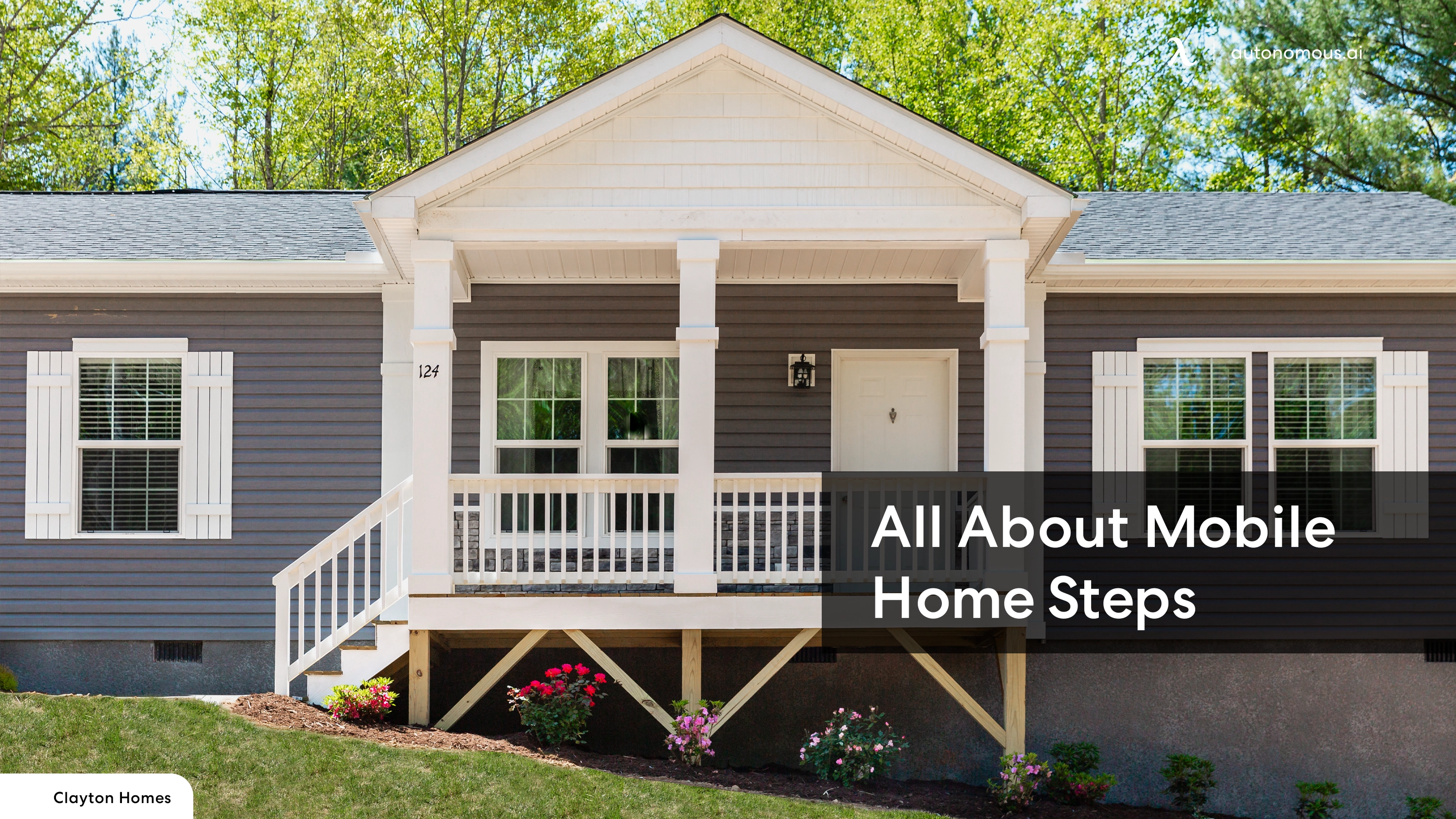
DIY Mobile Home Steps to Enhance Accessibility and Safety
Table of Contents
- Different Types of Mobile Home Steps
- Differences Between Mobile Home Steps and Mobile Home Stairs
- Components of Mobile Home Stairs and Steps
- What Fits Your Need: Build or Purchase?
- Make Your Own Mobile Home Step: How to Build Steps for a Mobile Home
- What Are the Standard Dimensions for Mobile Home Steps?
- Choosing the Best Materials for Mobile Home Steps?
- Are There Any Building Codes or Regulations for Mobile Home Steps?
- Autonomous ADUs Are Great Alternatives to Mobile Homes
- Final Thoughts
Once the main business of ordering your ADU and getting it installed in the perfect place in your yard is complete, you have to start thinking about some of the extras you will need to make your tiny house more comfortable and accessible. One of these things is a set of mobile home steps.
If you have a prefab unit or mobile home that you regularly use, the last thing you want is to struggle to get in and out of the house all the time. You need to invest in some steps for a mobile home to be convenient and serve its purpose well.
One of the most important things you will have to consider is the type of steps you want and the material. There are lots of great mobile home steps ideas out there, but not all of them will be best suited for your needs.
By looking at the type of prefab pool house, home office, garden shed, or backyard home office that you have, you should be able to pick the perfect steps to go with it.
This article will look at the different types of mobile home steps that are available for all kinds of prefabricated cabins, the various things you need to consider before buying, and some great ADUs to consider from Autonomous.
Different Types of Mobile Home Steps
One thing you will realize is that you have limitless possibilities in terms of materials, design, and functionality when it comes to choosing steps for a mobile home. If you enjoy DIY projects, you can consider building your own mobile home steps rather than buying ready-made steps.
However, if you would rather not waste time thinking about how to build mobile home steps, buying prefabricated products is the best solution. There are so many great mobile home steps ideas to choose from that all you need is a bit of research to find what you are looking for.
In most cases, wood mobile home steps are the favored choice for mobile homes and studio kits. However, you should feel free to choose any other material that you think will go well with your ADU. Consider the following five options:
Wood
The abundance of wood as a construction material means that in most cases, wood mobile home steps are the most popular option. You will find a variety of great designs made from many types of wood.
However, because there are so many types of wood to choose from, picking the right one for your modular guest house can be tricky. It is not just a matter of picking whatever steps you think will look great on your ADU, although this is also an important consideration.
When buying wood, consider its inherent issues, such as rotting, termite infestation, warping, and unreliable stability when manufactured poorly.
Most ADU owners choose either pressure-treated wood, cedar, composite, or redwood. It all depends on local availability, price, and the specific features that are needed, such as the water-resistant capabilities of cedar wood.
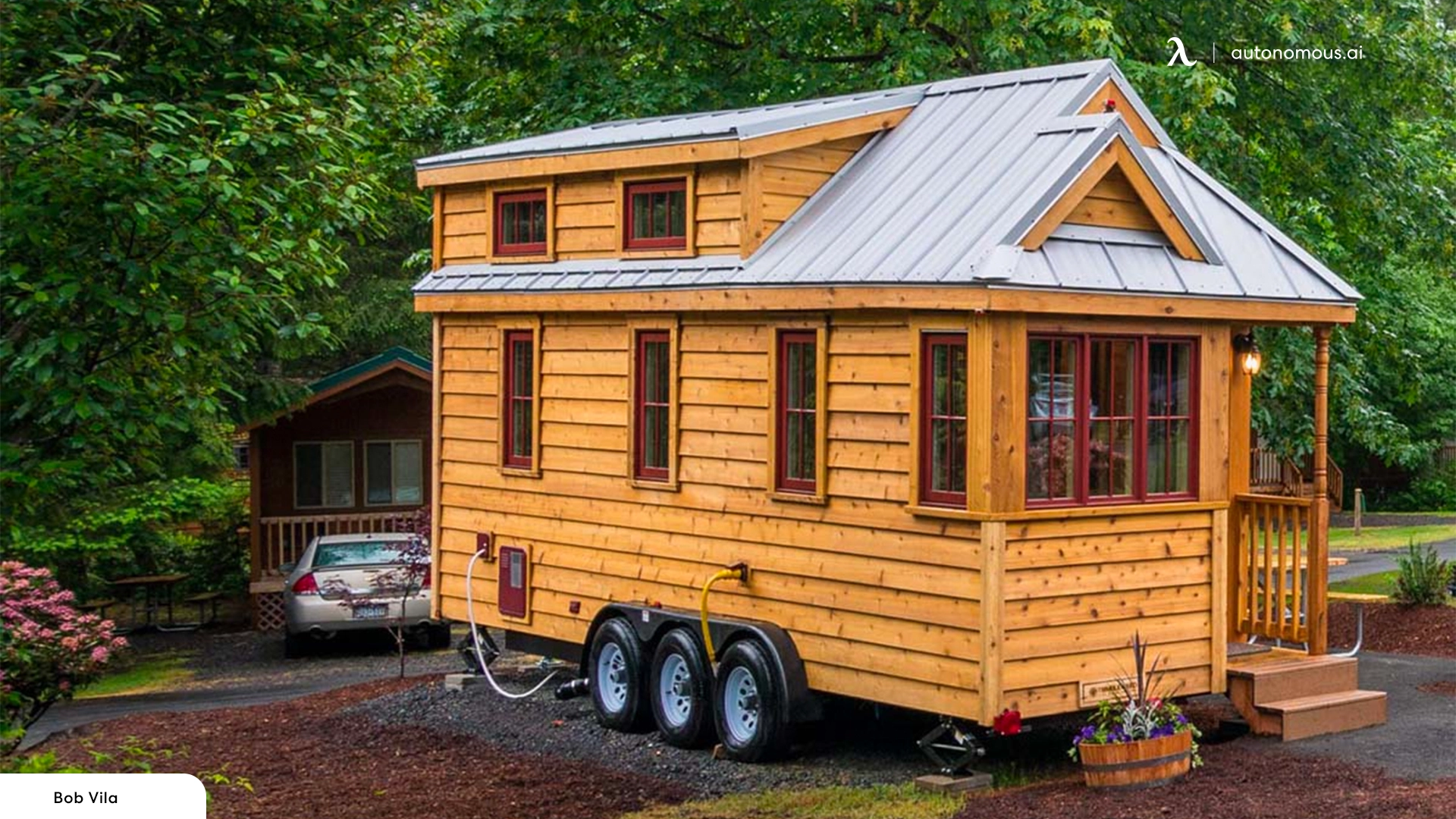
Plastic
The popularity of PVC and polyethylene products means it is quite common to find plastic mobile home steps ideas on the market. With a proper recycling plan, plastic products can be used safely without harming the environment.
However, PVC products do have certain issues that you will need to consider, such as being slippery when wet, sagging in the middle, and sometimes looking cheap compared to other products.
If you want great-looking mobile home steps, plastic is usually not your first choice. In most cases, to make plastic steps look better, the material can be mixed with wood or other materials.
Concrete
If you would rather have a more permanent type of mobile home steps, concrete is your best option. Even with limited maintenance, concrete steps can easily last 100 years, which is more than enough of a lifespan for any mobile home or ADU.
The low cost of building concrete steps also makes them a perfect choice for homeowners looking for a budget-friendly option for their tiny houses.
However, concrete steps are very heavy, which means you will need to make sure the underlying ground can handle the weight. Also, moving them will be a huge challenge so they are best reserved for permanent fixtures.
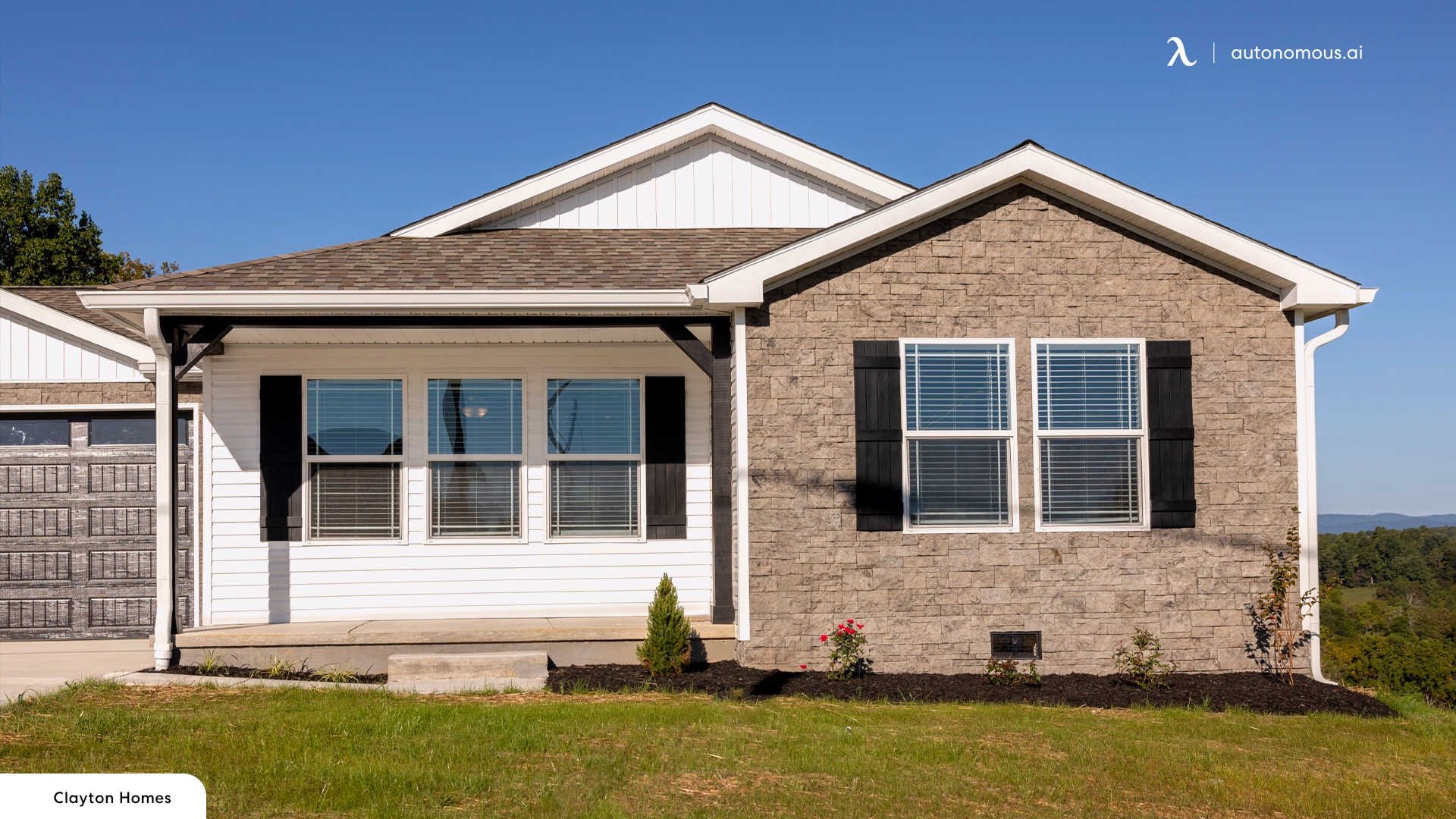
Fiberglass
When you want the perfect combination between strength and lightweight material, fiberglass mobile home steps are the favored choice. Installing fiberglass steps means you do not have to worry much about the underlying ground or face any difficulties when you want to move the steps.
Using fiberglass also means your steps will be highly resistant to all kinds of extreme weather conditions, such as heat, rain, or snow. Many homeowners are choosing fiberglass mobile home steps ideas over wood mobile home steps these days. The only downside is that fiberglass can be very expensive compared to cheaper options, such as concrete.
Metal
In terms of strength and rigidity, you cannot do any better than metal mobile home steps. A lot less material can be used to achieve the same strength and durability as a very heavy set of concrete steps.
While not as light as plastic or fiberglass, moving metal mobile home steps around is not as difficult as concrete. It is for this reason that you will find lots of mobile homes, ADUs, and RVs with their own set of metal steps.
Another advantage of having metal steps is that they are very affordable. However, this type of material is prone to rust, especially when used in wet environments. If that is the case, you may need to find special types of metal that are rust-resistant.
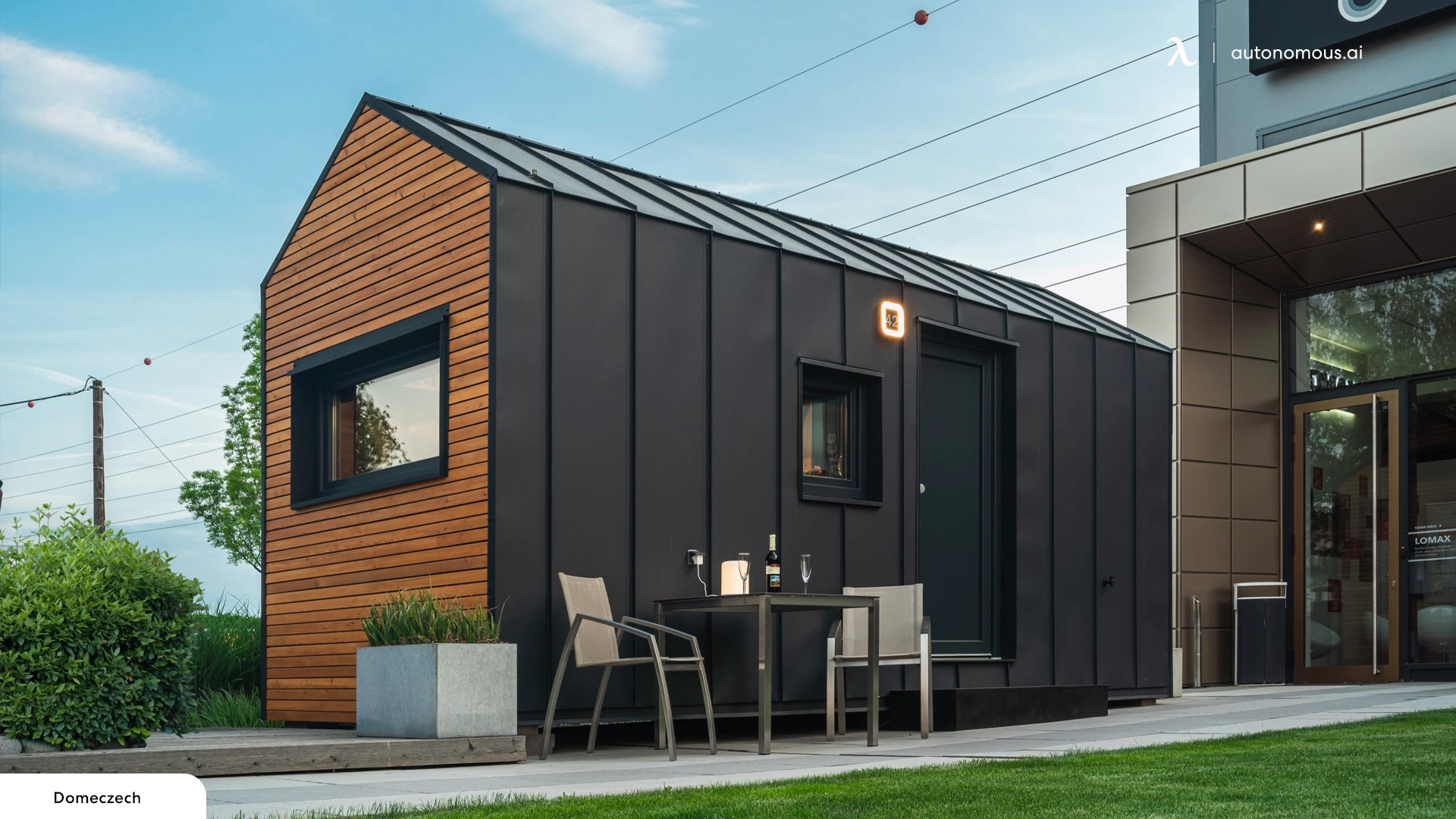
Differences Between Mobile Home Steps and Mobile Home Stairs
If you own a mobile home, the entryway must be both secure and easily accessible. The steps and stairs in your mobile home play a significant part in boosting the general accessibility and safety of your house.
We will look into the fundamental distinctions between DIY mobile home steps and stairs, as well as the components that make them up, and we will help you choose if constructing your own or buying a pre-made solution is the best match for you based on your specific requirements. Let's get started!
| Mobile Home Steps | Mobile Home Stairs |
| Consist of a series of individual steps forming a staircase leading to the entryway. | Include a broader platform with handrails on both sides, providing enhanced safety and aesthetics. |
| DIY-friendly for those who prefer to build their steps using mobile home steps plans and ideas. | Often require professional installation due to their complexity and to ensure stability and safety. |
| They are suitable for different entry heights and ideal for ground-level or slightly elevated entrances. | Provide easy access to mobile homes with higher entry points, which is especially beneficial for individuals with mobility challenges. |
| Generally more cost-effective compared to stairs, making them budget-friendly. | Tend to be more expensive due to their larger structure and additional materials required. |
Components of Mobile Home Stairs and Steps
Following are the components of mobile home stairs and steps:
Treads: The treads are the horizontal surfaces on which you step when using the stairs. They provide a stable, secure area for walking up or down the staircase.
Risers: Risers are the vertical fronts of each step, forming the space between two consecutive treads. They help define the height of each step and ensure proper spacing between them.
Stringers: Stringers are the diagonal supports that hold the steps together and provide structural integrity to the staircase. They are typically made of wood or metal and form the framework on which the treads and risers are attached.
Handrails: Handrails are crucial safety features of mobile home stairs, offering support and stability while ascending or descending. They run parallel to the staircase and are mounted on the walls or supported by balusters.
Balusters (or Spindles): Vertical posts support the handrail and prevent people from falling off the staircase. They are typically evenly spaced along the length of the handrail.
Newel Posts: Newel posts are larger, more robust posts positioned at the bottom and top of the staircase and sometimes at intermediate points. They provide additional support for the handrail and balusters.
Railings: Railings refer to the combination of handrails, balusters, and newel posts, creating a protective barrier along the open sides of the staircase.
Landings: Unlike stairs, mobile home steps may have a landing at the top of the steps. A landing is a larger flat surface that provides a transition area between the steps and the mobile home's entryway.
Support Brackets: Mobile home steps may use support brackets to reinforce the structure, especially if freestanding steps are not attached directly to the mobile home.
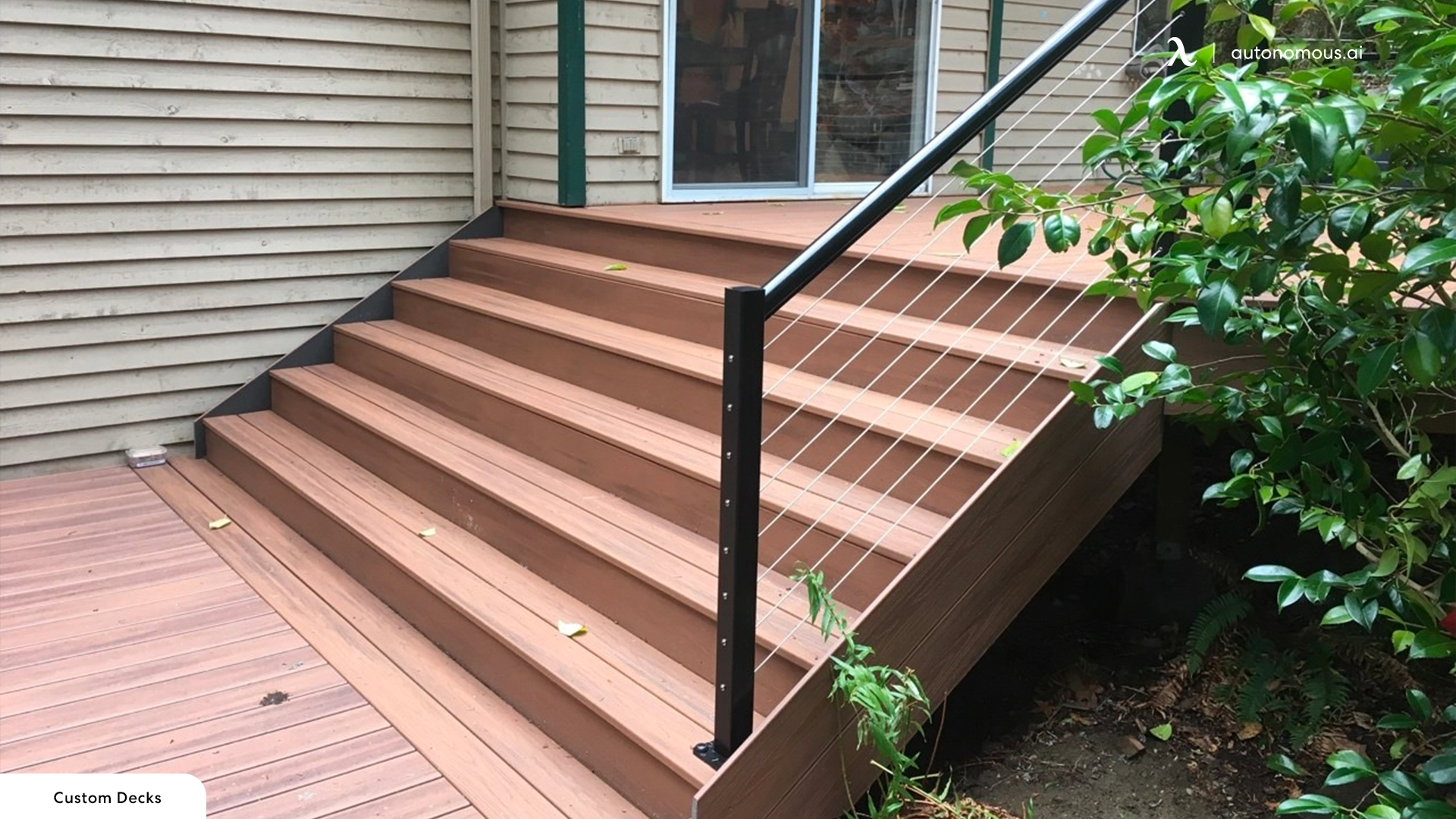
What Fits Your Need: Build or Purchase?
Build
Following are the pros and cons of building DIY mobile home steps:
Pros
- Buying your own mobile home steps or stairs can lead to significant cost savings, making it a budget-friendly option.
- Building allows you to personalize the design, materials, and finish to match your mobile home's style and preferences perfectly.
- For DIY enthusiasts, constructing the steps or stairs can be a fulfilling and enjoyable project, fostering a sense of accomplishment.
Cons
- Building mobile home steps or stairs requires careful planning, measuring, and construction, consuming more time and effort compared to purchasing pre-made solutions.
- Constructing stairs, in particular, demands expertise and precision to ensure safety and compliance with building codes. Lack of experience may lead to suboptimal results.
- If not constructed correctly, DIY steps or stairs may pose safety hazards. Proper construction guidelines and attention to safety measures are essential.
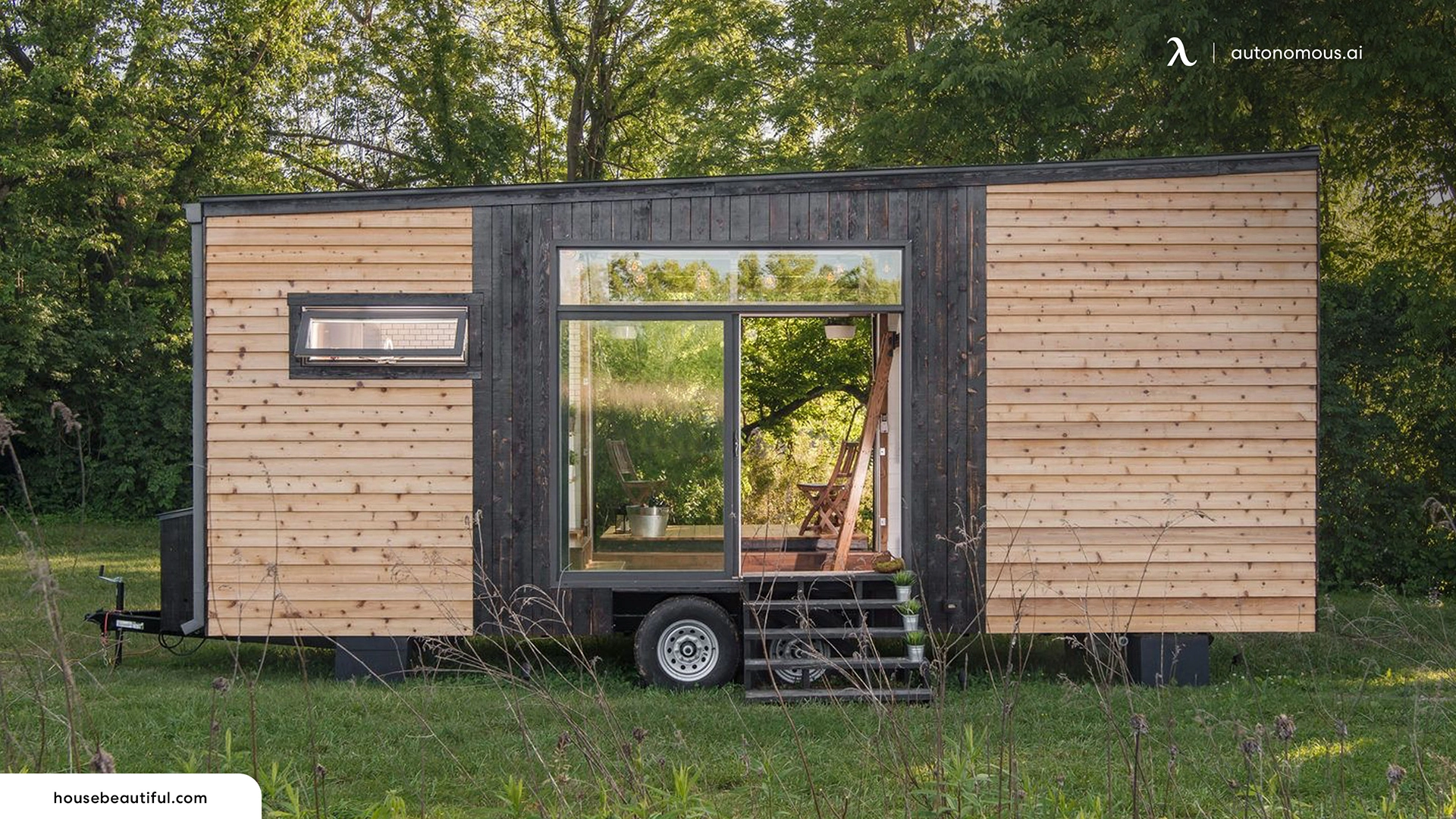
Purchase
Following are the pros and cons of purchasing DIY mobile home steps:
Pros
- Purchasing premade mobile home steps or stairs offers a convenient and time-saving solution. With ready-made options, you can skip construction and save time.
- Premade steps or stairs are typically constructed by experts, ensuring high quality, safety, and adherence to building standards.
- Many pre-made solutions come with warranties and customer support, offering reassurance in case of any issues or concerns.
Cons
- Purchasing premade steps or stairs can be more expensive than building them yourself, as you're paying for the convenience and professional construction.
- Depending on the supplier, shipping and handling costs might be associated with purchasing premade steps or stairs.
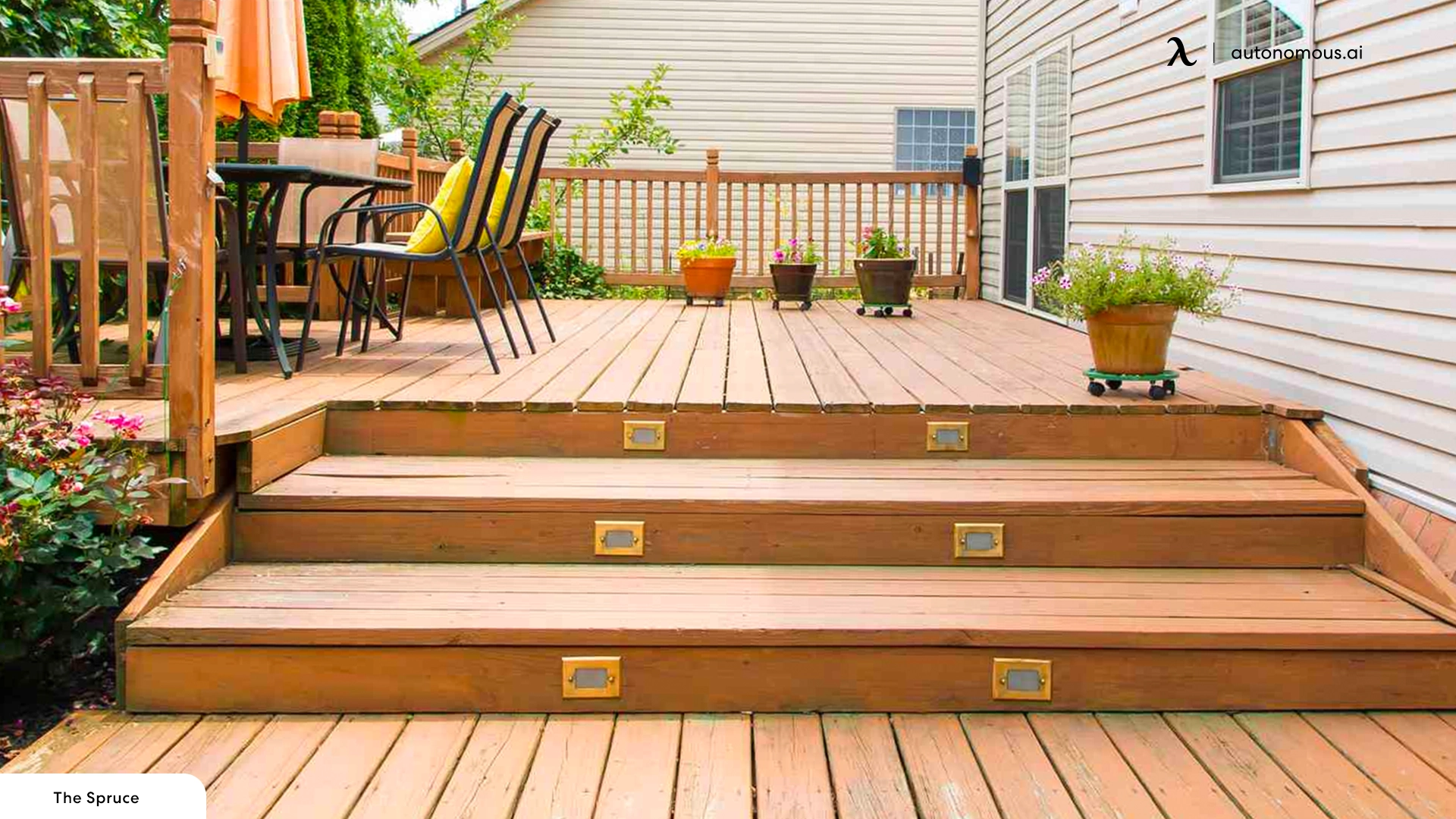
Make Your Own Mobile Home Step: How to Build Steps for a Mobile Home
Building your own mobile home steps can be a rewarding and cost-effective project, offering a personalized touch to your home's entrance. With some creativity and essential tools, you can construct steps that perfectly match your mobile home's style. Here are some mobile home steps ideas and a step-by-step guide to building your own steps:
Mobile Home Steps Ideas
- Wooden Elegance: Create classic wooden steps using treated lumber for durability. You can add decorative balusters and a handrail to enhance the elegance of the design.
- Stone Accents: Incorporate natural stone as risers or treads to add a rustic and charming touch to your mobile home's entry.
- Tiered Garden Steps: Combine functionality and beauty by integrating planter boxes into your steps, showcasing colorful flowers and plants.
Step-by-Step Guide to Building Mobile Home Steps
- Measure and Plan: Measure the height from the ground to your mobile home's entrance to determine the number of steps needed. Sketch out your design, considering the width and depth of each step.
- Gather Materials: Purchase the necessary materials, including pressure-treated lumber for the frame and steps, galvanized screws, concrete mix, and any desired decorative elements.
- Build the Frame: Construct the frame using the measured dimensions. Secure the stringers vertically, ensuring they are evenly spaced and level.
- Install the Treads and Risers: Attach the treads (horizontal surfaces) to the stringers. If you prefer risers (vertical fronts), fix them in place between each tread.
- Add Support and Stability: Ensure the steps are stable and provide additional support if needed. Consider adding handrails for safety.
- Finish and Decorate: Sand the surfaces for a smooth finish and apply a weather-resistant sealant or paint for added protection and aesthetic appeal.
- Installation: Carefully position the steps in front of your mobile home's entrance and level them. Use the concrete mix to secure them in place, providing a solid foundation.
With a touch of creativity and following the step-by-step guide, you can build custom mobile home steps that elevate the look and functionality of your entryway. Enjoy the satisfaction of a DIY project that enhances your home's accessibility and reflects your personal style.
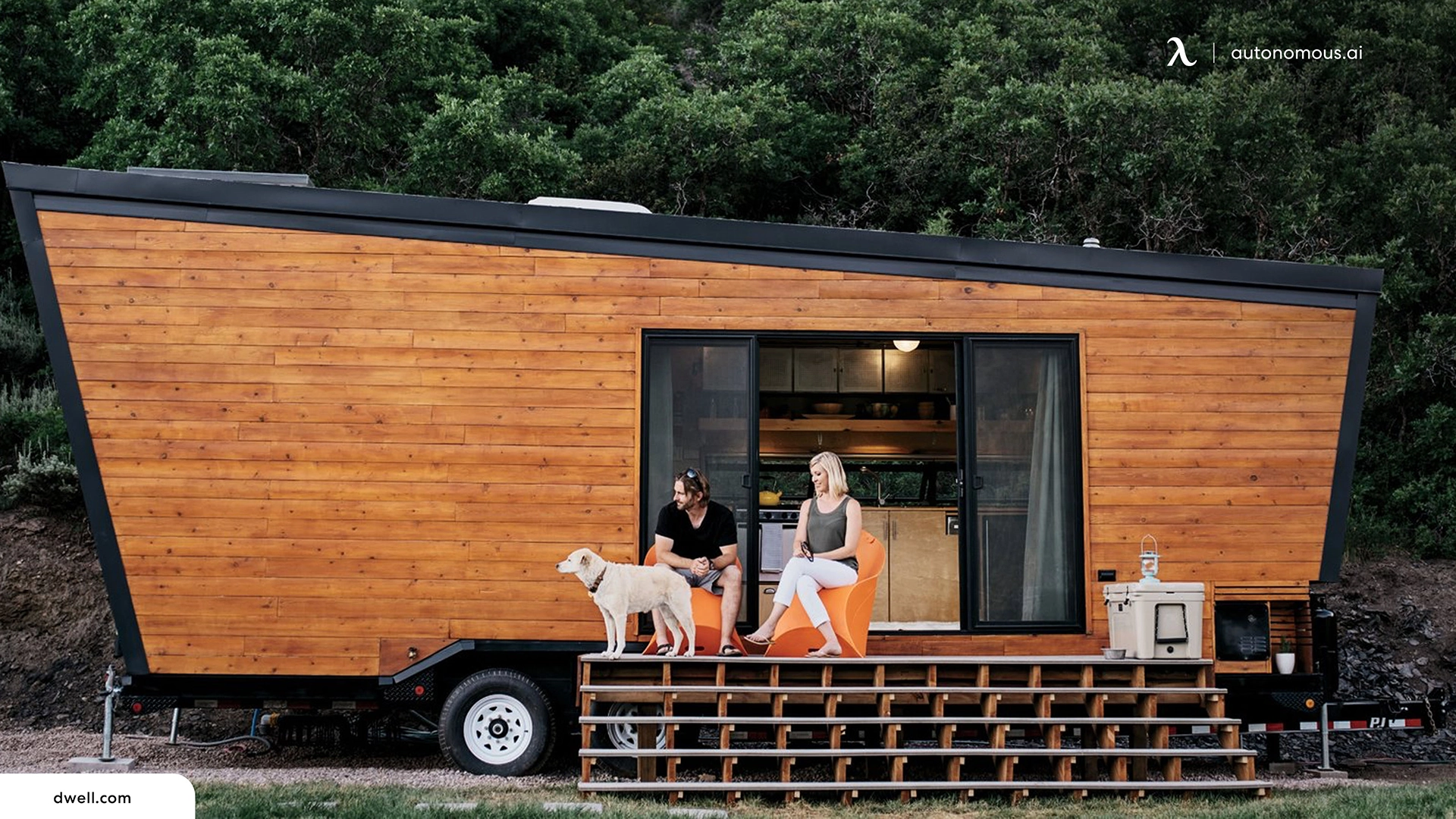
What Are the Standard Dimensions for Mobile Home Steps?
When you are considering adding some mobile home steps to your ADU, you have to first know how to build mobile home steps according to the standard requirements in terms of dimensions.
This means your mobile home steps have to comply with the following:
- The standard height of risers (height of each step) should be around 7.75 inches or as determined by local regulations.
- Run depth, which is the size of the step, should be a minimum of around 8.25 to 9 inches.
- Stringers are necessary to support the tread, and if the steps are wider than 36 inches, there will need to be three stringers in place, one on each side and another one in the middle.
- The ideal slope, or diagonal aspect of the steps, should be around 30 to 35 degrees.
- The part that you step on is called the tread, and it is usually supposed to be around 1 to 1.25 inches thick and 10.5 to 11.5 inches wide.
- If the steps have a nose protruding at the end of each step, it should not be longer than 1 inch.
- Steps that have four risers or more are required to have handrails or banisters. These are usually supposed to have a height of about 34 inches.
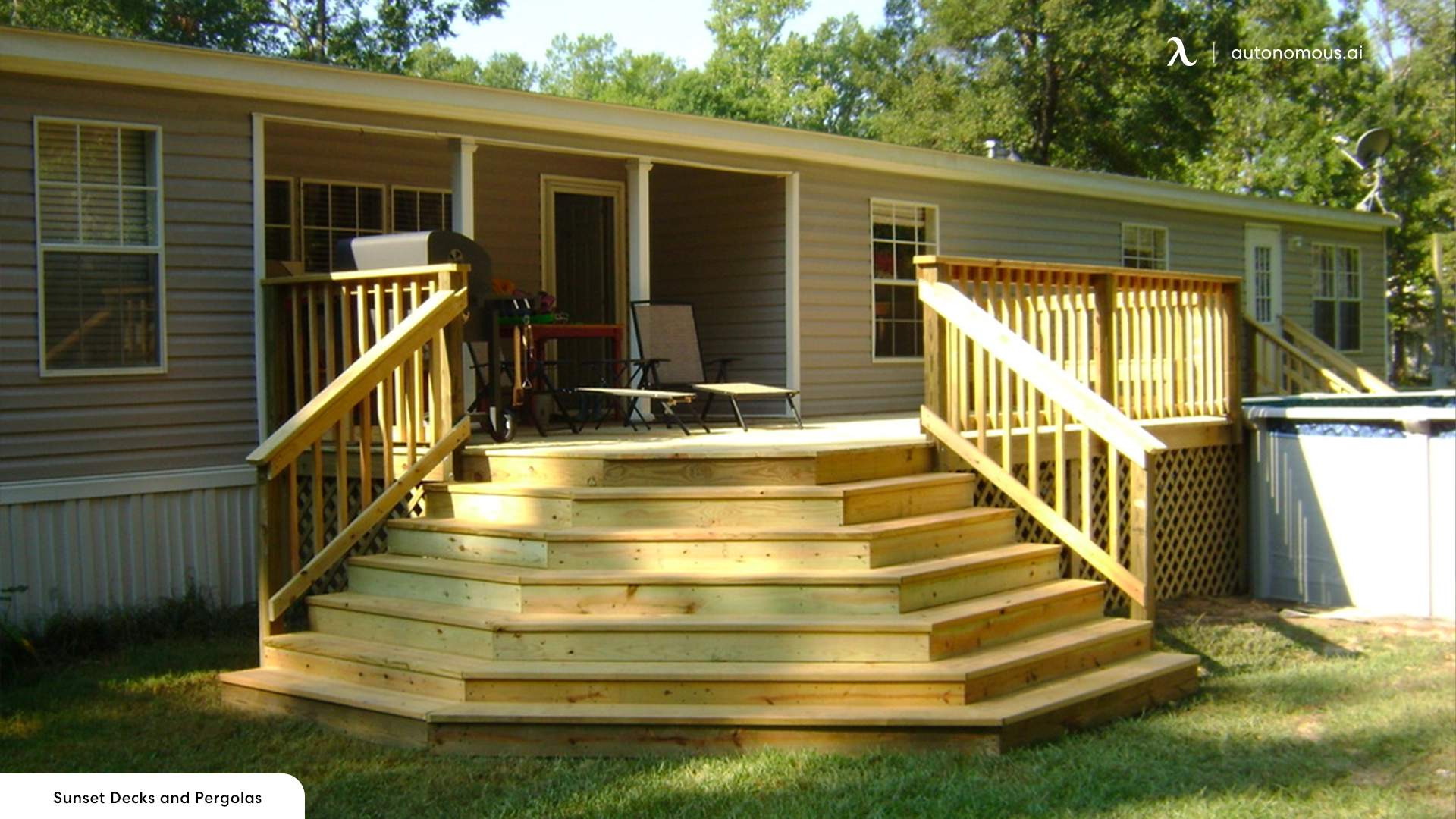
Choosing the Best Materials for Mobile Home Steps?
If you are going to end up with the perfect mobile home steps for your ADU or mobile home, you will need to choose the best materials for the job. A wrong choice here will mean that sooner, rather than later, you will have to start considering replacing your steps again, which will be an added expense.
To make sure you get your mobile home steps ideas right the first time in terms of material, consider the following:
Cost
If you are in the market for affordable small cabin kits for under $15,000, it means that you have a budget that you need to stick to, so the cost of the mobile home steps is something you will need to carefully consider.
Cheaper materials, such as metal or plastic may be the better option in this regard, rather than going for fiberglass or other expensive types of wood mobile home steps.
(1).webp)
Durability
Steps for a mobile home need to last as long as possible because this is not something you want to replace every few years. Concrete mobile home steps have been known to last 100 years, which makes them the best option in terms of durability.
When considering the cost of the steps, avoid choosing very cheap materials that do not last long. A good balance between the two is what you should aim for.
Appearance
With large houses, people often worry about curb appeal. While an ADU is a lot smaller, appearance is still important.
A well-designed set of steps will go a long way to improving the look of your mobile home. The mobile home steps are the first things that any visitors will see, so they have to look perfect all the time.
Weather Resistance
Carefully consider the type of weather that you normally experience in the area you live in. This should influence your choice of material because you need your mobile home steps to be able to withstand any type of weather they are exposed to. If you live in extremely wet areas, for example, wood may not be the ideal material. Go for fiberglass instead.
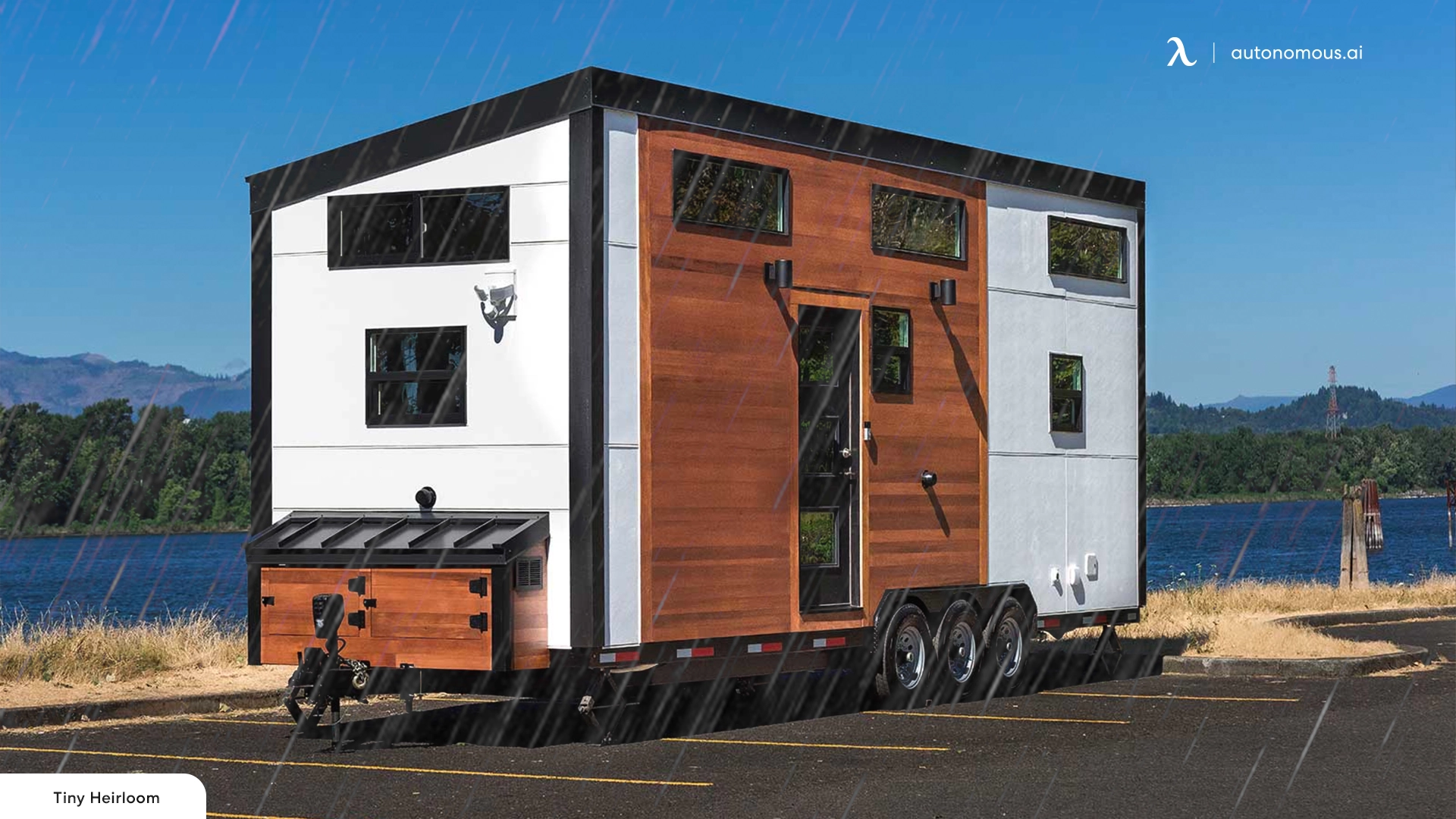
Are There Any Building Codes or Regulations for Mobile Home Steps?
Usually, the best thing to do is to check with your local municipality regarding the various rules and regulations regarding mobile homes and ADUs, in particular the rules on mobile home steps. You may find that certain ADU-friendly states, such as California, will give less stringent rules, while the opposite may be true in states such as New York.
Some of the building codes and regulations regarding the dimensions of your mobile home steps have already been mentioned above. However, there are a lot more regulations to consider, so it is best to request a copy of the building code from your local municipality before you commence building your mobile home steps.
Autonomous ADUs Are Great Alternatives to Mobile Homes
If you are looking for a better option besides regular mobile homes, try Autonomous ADUs. There are three awesome choices to consider, and all of them have great features and top-quality material. You can take a look at each of them and decide which one is best suited for your needs.
The WorkPod, for example, is a great choice if you are looking for a versatile ADU that can be used for a wide range of activities. This is a work-from-home pod that can double as an extra bedroom when the need arises. Similarly, you can try the equally splendid WorkPod Versatile, which is best suited for those looking for a more private home studio.
Last, but not least, is the WorkPod mini. An affordable backyard ADU that is capable of going toe-to-toe with much bigger prefab sheds in terms of functionality and features. Any of these three choices would make excellent additions to your backyard. As a bonus, you do not even require a building permit for these structures in most localities.
Final Thoughts
The mobile home steps of your ADU should never be overlooked because this is one of the features you will be using the most. There are many options to choose from, so it is best to take your time and look at what works best for the Autonomous ADU of your choice.
Stay connected with us!
Subscribe to our weekly updates to stay in the loop about our latest innovations and community news!
Interested in a Link Placement?
Spread the word
.svg)
.svg)




/https://storage.googleapis.com/s3-autonomous-upgrade-3/production/ecm/230914/bulk-order-sep-2023-720x1200-CTA-min.jpg)

/https://storage.googleapis.com/s3-autonomous-upgrade-3/static/upload/images/new_post_author/admin-1.png)